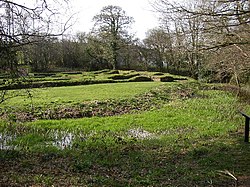Penhallam: Difference between revisions
Created page with "{{Infobox house |name=Penhallam |county=Cornwall |village=Jacobstow |picture=The ruins of Penhallam Moated Manor House - geograph.org.uk - 23988.jpg |picture caption=Penhallam..." |
No edit summary |
||
| Line 13: | Line 13: | ||
|used= | |used= | ||
|condition=Ruined | |condition=Ruined | ||
|ownership= | |ownership=English Heritage | ||
|open_to_public=Yes | |open_to_public=Yes | ||
}} | }} | ||
'''Penhallam''' is the site of a mediæval manor house surrounded by a protective moat. It was designated as a Scheduled Monument in 1996 and is now in the guardianship of [[English Heritage]]. | '''Penhallam''' is the site of a mediæval manor house surrounded by a protective moat. It was designated as a Scheduled Monument in 1996 and is now in the guardianship of [[English Heritage]]. | ||
Latest revision as of 13:00, 4 April 2016
| Penhallam | |
| Cornwall | |
|---|---|
 Penhallam Manor House | |
| Location | |
| Location: | 50°44’56"N, 4°31’6"W |
| Village: | Jacobstow |
| History | |
| Moated manor house | |
| Information | |
| Condition: | Ruined |
| Owned by: | English Heritage |
Penhallam is the site of a mediæval manor house surrounded by a protective moat. It was designated as a Scheduled Monument in 1996 and is now in the guardianship of English Heritage.
Details
The site is in the civil parish of Jacobstow in north-eastern Cornwall, a mile west of Week St Mary and seven miles south of Bude.
The site is a grass-covered ruin showing the complete ground-plan of the manor. The manor dates from the late 12th century and was abandoned during the mid-14th century. Penhallam is one of only four such moated mediæval manor sites in Cornwall and it consists of a quadrangle of buildings around a central courtyard.[1]
Some excavations took place between 1968–1973 and the foundation trenches recorded by excavation can be seen as low, wire-framed and turf-covered earth banks.
History
Historical records [2] show that the manor of Penhallam formed part of the honour of Cardinham, held by Richard fitz Turold in 1087, and by his descendants (eventually the de Cardinham family). The male line became extinct with the death of Andrew de Cardinham in about 1256.
By 1270, Andrew's heiress, Isolda de Cardinham, had given Penhallam to the Champernowne family, who held the manor for the rest of the manor's habitation. During much of the early 14th century, it was occupied by the Beaupre family as tenants. It is thought that the site was abandoned by about 1428 when the land was divided into six partitions.[3]
The manor was originally reached by a drawbridge over the moat. Later on in the 13th century a fixed stone bridge was built.[1]
Outside links
- Penhallam Manor – English Heritage]
References
- ↑ 1.0 1.1 Access to Monuments: Penhallam (Historic Cornwall)
- ↑ Mediæval Archaeology: journal of the Society for Mediæval Archaeology; 18 (1974), pp. 90-145
- ↑ National Monuments Record: No. 436500 – Penhallam Manor